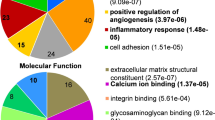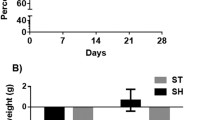Abstract
Social isolation (SI) increases ischemic injury and significantly delays recovery after experimental stroke. Changes in circulating microRNAs (miRNAs) have been implicated in several neurological disorders, including stroke. However, potential biomarkers to elucidate the mechanisms that underlie the detrimental effects of post-stroke isolation are unknown. Aged C57BL/6 male and female mice (18–20 months) were subjected to a 60-min middle cerebral artery occlusion followed by reperfusion and were assigned to either isolation (SI) or continued pair housing (PH) immediately after stroke. On day 15, mice were sacrificed, and plasma samples were collected for miRNAome analysis. Top candidate miRNAs and their biological functions were identified using integrated bioinformatics. The miRNAome analysis revealed a total of 21 differentially expressed miRNAs across both sexes with fold change of 3 or higher. Within the female cohort, miR-206-3p, -376a-3p, -34b-5p, -133a-5p, -466f, and -671-3p were highly altered relative to the PH housing condition. Similarly in males, miR-376c-3p, -181d-5p, -712-5p, -186-5p, -21a-3p, -30d-3p, -495-3p, -669c-5p, -335-5p, -429-3p, -31-3p, and -217-5p were identified. Following Kyoto Encyclopedia of Genes and Genomes analysis, the identified miRNAs effected distinct subset of pathways within sexes. Interactional network analysis revealed miR-495-3p (male) and miR-34b-5p (female) as pivotal nodes that targeted the largest subset of genes. We identified several sex-specific miRNAs as candidate biomarkers for post-stroke SI in aged male and female mice. Additionally, these results suggest that there is potential to use plasma-based circulating miRNAs as a source of novel biomarkers to identify biological pathways involved in post-stroke SI.




Similar content being viewed by others
Data Availability
All data and supporting material details of this study are available from the corresponding or first author of the article on reasonable request.
References
Ahnstedt, H., Patrizz, A., Chauhan, A., Roy-O’Reilly, M., Furr, J. W., Spychala, M. S., et al. (2020). Sex differences in T cell immune responses, gut permeability and outcome after ischemic stroke in aged mice. Brain, Behavior, and Immunity, 87, 556–567. https://doi.org/10.1016/j.bbi.2020.02.001
Antony, M., Scranton, V., Srivastava, P., & Verma, R. (2020). Micro RNA 181c–5p: A promising target for post-stroke recovery in socially isolated mice. Neuroscience Letters, 715, 134610. https://doi.org/10.1016/j.neulet.2019.134610
Bahi, A. (2017). Hippocampal BDNF overexpression or microR124a silencing reduces anxiety- and autism-like behaviors in rats. Behavioural Brain Research, 326, 281–290. https://doi.org/10.1016/j.bbr.2017.03.010
da Huang, W., Sherman, B. T., & Lempicki, R. A. (2009a). Bioinformatics enrichment tools: Paths toward the comprehensive functional analysis of large gene lists. Nucleic Acids Research, 37(1), 1–13. https://doi.org/10.1093/nar/gkn923
da Huang, W., Sherman, B. T., & Lempicki, R. A. (2009b). Systematic and integrative analysis of large gene lists using DAVID bioinformatics resources. Nature Protocols, 4(1), 44–57. https://doi.org/10.1038/nprot.2008.211
Dweep, H., & Gretz, N. (2015). miRWalk2.0: A comprehensive atlas of microRNA-target interactions. Nature Methods, 12(8), 697. https://doi.org/10.1038/nmeth.3485
Dykstra-Aiello, C., Jickling, G. C., Ander, B. P., Shroff, N., Zhan, X., Liu, D., et al. (2016). Altered expression of long noncoding RNAs in blood after ischemic stroke and proximity to putative stroke risk loci. Stroke, 47(12), 2896–2903. https://doi.org/10.1161/strokeaha.116.013869
Evans, I. E. M., Llewellyn, D. J., Matthews, F. E., Woods, R. T., Brayne, C., & Clare, L. (2018). Social isolation, cognitive reserve, and cognition in healthy older people. PLoS ONE, 13(8), e0201008. https://doi.org/10.1371/journal.pone.0201008
Fan, Y., Siklenka, K., Arora, S. K., Ribeiro, P., Kimmins, S., & Xia, J. (2016). miRNet: Dissecting miRNA-target interactions and functional associations through network-based visual analysis. Nucleic Acids Research, 44(W1), W135-141. https://doi.org/10.1093/nar/gkw288
Fleisch Marcus, A., Illescas, A. H., Hohl, B. C., & Llanos, A. A. (2017). Relationships between social isolation, neighborhood poverty, and cancer mortality in a population-based study of US adults. PLoS ONE, 12(3), e0173370. https://doi.org/10.1371/journal.pone.0173370
Häfner, S., Emeny, R. T., Lacruz, M. E., Baumert, J., Herder, C., Koenig, W., et al. (2011). Association between social isolation and inflammatory markers in depressed and non-depressed individuals: Results from the MONICA/KORA study. Brain, Behavior, and Immunity, 25(8), 1701–1707. https://doi.org/10.1016/j.bbi.2011.06.017
Hayakawa, K., Kato, T. A., Watabe, M., Teo, A. R., Horikawa, H., Kuwano, N., et al. (2018). Blood biomarkers of Hikikomori, a severe social withdrawal syndrome. Science Report, 8(1), 2884. https://doi.org/10.1038/s41598-018-21260-w
Kadri, F., LaPlante, A., De Luca, M., Doyle, L., Velasco-Gonzalez, C., Patterson, J. R., et al. (2016). Defining plasma microRNAs associated with cognitive impairment in HIV-infected patients. Journal of Cellular Physiology, 231(4), 829–836. https://doi.org/10.1002/jcp.25131
Kaidonis, G., Rao, A. N., Ouyang, Y. B., & Stary, C. M. (2019). Elucidating sex differences in response to cerebral ischemia: immunoregulatory mechanisms and the role of microRNAs. Progress in Neurobiology, 176, 73–85. https://doi.org/10.1016/j.pneurobio.2018.08.001
Karnati, H. K., Panigrahi, M. K., Gutti, R. K., Greig, N. H., & Tamargo, I. A. (2015). miRNAs: Key players in neurodegenerative disorders and epilepsy. J Alzheimers Dis, 48(3), 563–580. https://doi.org/10.3233/jad-150395
Klein, S. L., & Flanagan, K. L. (2016). Sex differences in immune responses. Nature Reviews Immunology, 16(10), 626–638. https://doi.org/10.1038/nri.2016.90
Krol, J., Loedige, I., & Filipowicz, W. (2010). The widespread regulation of microRNA biogenesis, function and decay. Nature Reviews Genetics, 11(9), 597–610. https://doi.org/10.1038/nrg2843
Leigh-Hunt, N., Bagguley, D., Bash, K., Turner, V., Turnbull, S., Valtorta, N., et al. (2017). An overview of systematic reviews on the public health consequences of social isolation and loneliness. Public Health, 152, 157–171. https://doi.org/10.1016/j.puhe.2017.07.035
Li, H., Pin, S., Zeng, Z., Wang, M. M., Andreasson, K. A., & McCullough, L. D. (2005). Sex differences in cell death. Annals of Neurology, 58(2), 317–321. https://doi.org/10.1002/ana.20538
Li, Y., Fang, J., Zhou, Z., Zhou, Q., Sun, S., Jin, Z., et al. (2020). Downregulation of lncRNA BACE1-AS improves dopamine-dependent oxidative stress in rats with Parkinson’s disease by upregulating microRNA-34b-5p and downregulating BACE1. Cell Cycle, 19(10), 1158–1171. https://doi.org/10.1080/15384101.2020.1749447
Liu, L., Liu, L., Shi, J., Tan, M., Xiong, J., Li, X., et al. (2016). MicroRNA-34b mediates hippocampal astrocyte apoptosis in a rat model of recurrent seizures. BMC Neuroscience, 17(1), 56. https://doi.org/10.1186/s12868-016-0291-6
Lowry, C. A., & Jin, A. Y. (2020). Improving the social relevance of experimental stroke models: Social isolation, social defeat stress and stroke outcome in animals and humans. Front Neurol, 11, 427. https://doi.org/10.3389/fneur.2020.00427
Lu, T. X., & Rothenberg, M. E. (2018). MicroRNA. The Journal of Allergy and Clinical Immunology, 141(4), 1202–1207. https://doi.org/10.1016/j.jaci.2017.08.034
Mavrikaki, M., Pantano, L., Potter, D., Rogers-Grazado, M. A., Anastasiadou, E., Slack, F. J., et al. (2019). Sex-dependent changes in miRNA expression in the bed nucleus of the stria terminalis following stress. Frontiers in Molecular Neuroscience, 12, 236. https://doi.org/10.3389/fnmol.2019.00236
Metsalu, T., & Vilo, J. (2015). ClustVis: a web tool for visualizing clustering of multivariate data using Principal Component Analysis and heatmap. Nucleic Acids Research, 43(W1), W566-570. https://doi.org/10.1093/nar/gkv468
Nyatanga, B. (2017). Loneliness, social isolation and time alone in your shed. International Journal of Palliative Nursing, 23(9), 419. https://doi.org/10.12968/ijpn.2017.23.9.419
Olaizola, P., Lee-Law, P. Y., Arbelaiz, A., Lapitz, A., Perugorria, M. J., Bujanda, L., et al. (2018). MicroRNAs and extracellular vesicles in cholangiopathies. Biochimica et Biophysica Acta - Molecular Basis of Disease, 1864(4 Pt B), 1293–1307. https://doi.org/10.1016/j.bbadis.2017.06.026
Pohl, J. S., Cochrane, B. B., Schepp, K. G., & Woods, N. F. (2018). Falls and social isolation of older adults in the national health and aging trends study. Research in Gerontological Nursing, 11(2), 61–70. https://doi.org/10.3928/19404921-20180216-02
Rajman, M., & Schratt, G. (2017). MicroRNAs in neural development: from master regulators to fine-tuners. Development, 144(13), 2310–2322. https://doi.org/10.1242/dev.144337
Ross, A. P., McCann, K. E., Larkin, T. E., Song, Z., Grieb, Z. A., Huhman, K. L., et al. (2019). Sex-dependent effects of social isolation on the regulation of arginine-vasopressin (AVP) V1a, oxytocin (OT) and serotonin (5HT) 1a receptor binding and aggression. Hormones and Behavior, 116, 104578. https://doi.org/10.1016/j.yhbeh.2019.104578
Roy-O’Reilly, M., & McCullough, L. D. (2018). Age and sex are critical factors in ischemic stroke pathology. Endocrinology, 159(8), 3120–3131. https://doi.org/10.1210/en.2018-00465
Saadi, A., Okeng’o, K., Biseko, M. R., Shayo, A. F., Mmbando, T. N., Grundy, S. J., et al. (2018). Post-stroke social networks, depressive symptoms, and disability in Tanzania: A prospective study. International Journal of Stroke, 13(8), 840–848. https://doi.org/10.1177/1747493018772788
Schrempft, S., Jackowska, M., Hamer, M., & Steptoe, A. (2019). Associations between social isolation, loneliness, and objective physical activity in older men and women. BMC Public Health, 19(1), 74. https://doi.org/10.1186/s12889-019-6424-y
Smalheiser, N. R., Lugli, G., Rizavi, H. S., Torvik, V. I., Turecki, G., & Dwivedi, Y. (2012). MicroRNA expression is down-regulated and reorganized in prefrontal cortex of depressed suicide subjects. PLoS ONE, 7(3), e33201. https://doi.org/10.1371/journal.pone.0033201
Smith, S. G., Jackson, S. E., Kobayashi, L. C., & Steptoe, A. (2018). Social isolation, health literacy, and mortality risk: Findings from the English Longitudinal Study of Ageing. Health Psychology, 37(2), 160–169. https://doi.org/10.1037/hea0000541
Sohrabji, F., & Selvamani, A. (2019). Sex differences in miRNA as therapies for ischemic stroke. Neurochemistry International, 127, 56–63. https://doi.org/10.1016/j.neuint.2018.10.021
Stamova, B., Jickling, G. C., Ander, B. P., Zhan, X., Liu, D., Turner, R., et al. (2014). Gene expression in peripheral immune cells following cardioembolic stroke is sexually dimorphic. PLoS ONE, 9(7), e102550. https://doi.org/10.1371/journal.pone.0102550
Steptoe, A., Shankar, A., Demakakos, P., & Wardle, J. (2013). Social isolation, loneliness, and all-cause mortality in older men and women. Proceedings of National Academy of Science USA, 110(15), 5797–5801. https://doi.org/10.1073/pnas.1219686110
Sun, L., Min, L., Li, M., Shao, F., & Wang, W. (2018). Transcriptomic analysis reveals oxidative phosphorylation activation in an adolescent social isolation rat model. Brain Research Bulletin, 142, 304–312. https://doi.org/10.1016/j.brainresbull.2018.08.013
Sun, N., Lei, L., Wang, Y., Yang, C., Liu, Z., Li, X., et al. (2016). Preliminary comparison of plasma notch-associated microRNA-34b and -34c levels in drug naive, first episode depressed patients and healthy controls. Journal of Affective Disorders, 194, 109–114. https://doi.org/10.1016/j.jad.2016.01.017
Torres, J. L., Novo-Veleiro, I., Manzanedo, L., Alvela-Suárez, L., Macías, R., Laso, F. J., et al. (2018). Role of microRNAs in alcohol-induced liver disorders and non-alcoholic fatty liver disease. World Journal of Gastroenterology, 24(36), 4104–4118. https://doi.org/10.3748/wjg.v24.i36.4104
Valtorta, N. K., Kanaan, M., Gilbody, S., Ronzi, S., & Hanratty, B. (2016). Loneliness and social isolation as risk factors for coronary heart disease and stroke: Systematic review and meta-analysis of longitudinal observational studies. Heart, 102(13), 1009–1016. https://doi.org/10.1136/heartjnl-2015-308790
Verma, R., Ritzel, R. M., Harris, N. M., Lee, J., Kim, T., Pandi, G., et al. (2018). Inhibition of miR-141-3p ameliorates the negative effects of poststroke social isolation in aged mice. Stroke, 49(7), 1701–1707. https://doi.org/10.1161/strokeaha.118.020627
Wyczechowska, D., Lin, H. Y., LaPlante, A., Jeansonne, D., Lassak, A., Parsons, C. H., et al. (2017). A miRNA signature for cognitive deficits and alcohol use disorder in persons living with HIV/AIDS. Front Mol Neurosci, 10, 385. https://doi.org/10.3389/fnmol.2017.00385
Yu, B., Steptoe, A., Niu, K., Ku, P. W., & Chen, L. J. (2018). Prospective associations of social isolation and loneliness with poor sleep quality in older adults. Quality of Life Research, 27(3), 683–691. https://doi.org/10.1007/s11136-017-1752-9
Funding
This study was supported by grants from the NIH/NINDS, NSO55215 and 1R01NS096493 (to L.D.M.), RO1NS099531 and RO1NS101960 (to R.V.), an award from the American Heart Association and the American Brain Foundation 19POST34410076 (to J.L.), the American Heart Association grants 15SDG23250025 (to V.R.V.), and AHA-Student Scholarship in Cerebrovascular Disease and Stroke (to A.B.).
Author information
Authors and Affiliations
Contributions
AB, VRV, RV, and LDM designed the experiments for the study and wrote the manuscript. AB, AKC, JJS, JL, and VRV performed the experiments and analyzed the data.
Corresponding author
Ethics declarations
Conflict of interest
The authors have no conflict of interests to disclose.
Ethical Approval
The Institutional Animal Care and Use Committee at The University of Texas McGovern Medical School approved all animal protocols. All studies were performed in accordance with the guidelines provided by the National Institute of Health (NIH) and in accordance with the institutional ethical standards.
Informed Consent
This article does not contain any studies with human subjects/clinical samples.
Consent for Publication
All authors read and approved final version of the manuscript for submission.
Additional information
Publisher's Note
Springer Nature remains neutral with regard to jurisdictional claims in published maps and institutional affiliations.
Electronic supplementary material
Below is the link to the electronic supplementary material.
Rights and permissions
About this article
Cite this article
Banerjee, A., Chokkalla, A.K., Shi, J.J. et al. Microarray Profiling Reveals Distinct Circulating miRNAs in Aged Male and Female Mice Subjected to Post-stroke Social Isolation. Neuromol Med 23, 305–314 (2021). https://doi.org/10.1007/s12017-020-08622-2
Received:
Accepted:
Published:
Issue Date:
DOI: https://doi.org/10.1007/s12017-020-08622-2




